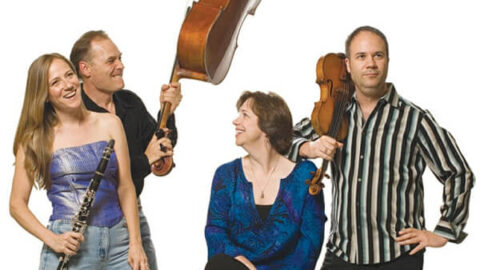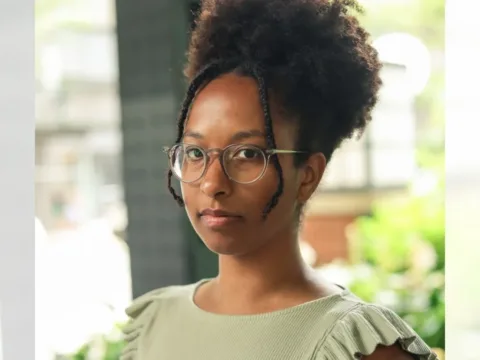 There were two wonderful opportunities over the past month for chamber music fans in Texas to experience fantastic performances of master works by leading contemporary American composers. The pair of concerts were on May 8 and 9 in San Antonio, and were presented by veteran new music group SOLI Chamber Ensemble. SOLI is a contemporary music quartet based in San Antonio, Texas, and is comprised of clarinetist Stephanie Key, violinist Ertan Torgul, cellist David Mollenauer, and pianist Carolyn True. They presented a youthful, energetic, and bold program of five works on May 8 at Trinity University’s Ruth Taylor Recital Hall. The program was repeated the following night at the McNay Art Museum, in the Leeper Auditorium. Of the five works performed over the two evenings, two pieces were premiere performances of specific arrangements, and one was a world premiere of a brand new collaborative work by composer Steven Mackey and video artist Mark DeChiazza.
There were two wonderful opportunities over the past month for chamber music fans in Texas to experience fantastic performances of master works by leading contemporary American composers. The pair of concerts were on May 8 and 9 in San Antonio, and were presented by veteran new music group SOLI Chamber Ensemble. SOLI is a contemporary music quartet based in San Antonio, Texas, and is comprised of clarinetist Stephanie Key, violinist Ertan Torgul, cellist David Mollenauer, and pianist Carolyn True. They presented a youthful, energetic, and bold program of five works on May 8 at Trinity University’s Ruth Taylor Recital Hall. The program was repeated the following night at the McNay Art Museum, in the Leeper Auditorium. Of the five works performed over the two evenings, two pieces were premiere performances of specific arrangements, and one was a world premiere of a brand new collaborative work by composer Steven Mackey and video artist Mark DeChiazza.
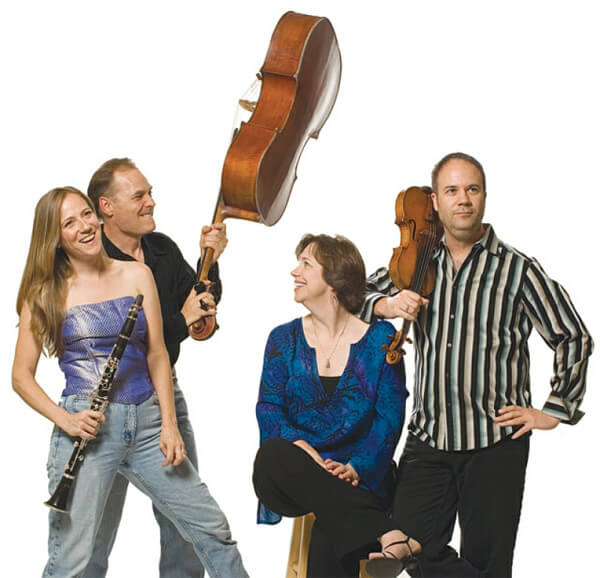
The concert kicked off with a premiere performance of New York-based composer Richard Carrick’s La scene miniature quartet, arranged for SOLI’s instrumentation. The piece was originally scored for violin, tenor saxophone, musical saw, and piano. At the outset of the work, Carrick’s work pairs violin with piano against, here, bass clarinet and cello. The piece explored contrasts of melodic figures with sonic gestures, microtonal melodic fragments, Algerian folk melodies, and North African dance patterns. Carrick’s work was rhythmically charged and quite colorful. David Mollenauer’s cello work very craftily mimicked the timbre of a musical saw. The piece was a perfect start to the evening.
Stephen Hartke’s The Horse with the Lavender Eye was next on the program, and it consisted of four contrasting, seemingly non sequitur episodes for violin, clarinet, and piano. According to Hartke’s notes, sense is made of the episodic piece as each of the four movements “have to do in one way or another with being off-balance.” The piece began with a movement written entirely for the players’ left hands. Hartke’s scoring confronted this limitation very cleverly putting the clarinet in the role of soloist with a highly angular melodic line, leaving the violin and piano as supporting instruments. The “in your face” second movement pitted violin and clarinet against each other, leaving the piano alternatively accompanying the two “leading” instruments. Stephanie Key’s high-flying clarinet work really shone on this movement. The third movement “Waltzing at the Abyss” was, by contrast, much more delicate and subdued in nature. Torgul, Key, and True handled the often exposed and rhythmically jilted lines with expert care and precision. While the subject matter of the movement may have suggested dancing dangerously close to the edge of oblivion, the trio’s performance never sounded anything less than assured and in control. The final movement really put on display the trio’s penchant for tackling highly challenging rhythmic lines and virtuosic passages with absolute ease in one breath, while turning on a dime to beautifully phrased down-tempo melodic passages without so much as batting an eye.
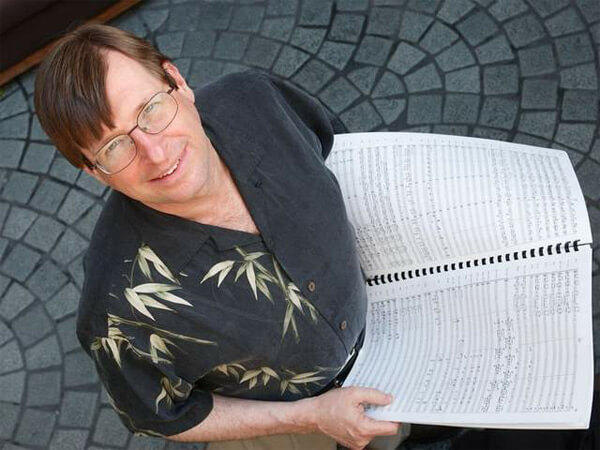
The third piece on the program was Paul Moravec’s Andy Warhol Sez, which was another premiere performance of an older work with new instrumentation. Originally for bassoon and piano, this work featured Stephanie Key on bass clarinet and Carolyn True on piano. Each of the seven short movements of this piece offered a quick and fun musical commentary on short and quirky quotations, each effectively delivered by Key.
Possibly the only weak piece on the program, by comparison to the strength of the other four works on the program, was Matt Haimovitz’s eight-cello arrangement of Led Zeppelin’s Kashmir. The performance featured Mollenauer as a soloist with an accompanying recording of himself playing the remaining seven parts. While Mollenauer’s live performance was expressive and adventurous, the pre-recorded parts came across as tame and a bit out of place for the iconic rock anthem.
By far the biggest draw for the evening’s program was the much touted and newly commissioned work by Steven Mackey and Mark DeChiazza, titled Prelude to the End. As with other recent works by Mackey (namely It is Time and Time Release), the focus of this work is on the composer’s own awareness of mortality and the inevitable end. With Prelude to the End, Mackey aimed to capture the “struggles and complications” of what he refers to as the failed attempts to recapture his youthful and former self. The work featured two key elements: one that was energetic, rhythmically charged, and reminiscent of an earlier period in his life, and the other a much darker, harmonically complex, and weighty sense of the current reality. Over the course of the piece, the latter element acted as a gravitational pull to the former. These pulls intensified, colorfully and dramatically, over the entire 15-minute work, and eventually won out in the end, causing the piece to come to a lull at the end of the work.
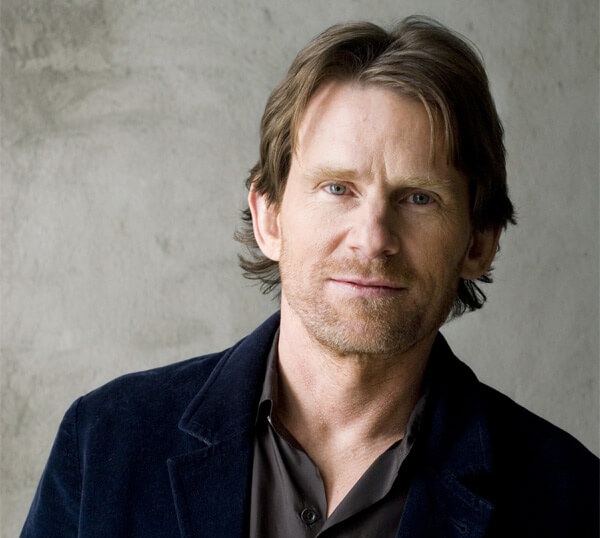
Given that SOLI’s instrumentation is the same as Olivier Messiaen’s famous Quatuor pour la fin du temps, Mackey pointed out that the group no doubt originally assembled to perform the monumental work. In light of this fact, the composer noted that “the trajectory of [the] piece from goofy to grave would be a good set up for [the] Quartet for the End of Time.” Throughout the piece, one could even hear small fragments and strains of what could be subtle nods to Messiaen’s quartet.
The video element of the work was directed by Mark DeChiazza, who has worked with Mackey on recent projects, such as his work It is Time for So Percussion and Slide, a musical theater work written and performed by Rinde Eckert and Mackey with eighth blackbird. In this video, dancer/choreographer Kristin Clotfelter was the sole performer and served as the visual depiction of the fizzled attempts to regain what once was. Throughout the work, Clotfelter either moved singly or was multiplied to appear to dance with or alongside herself. The images moved from full shots of her dancing to tight shots of softly moving hand gestures, as though she was reaching out to her former self. Visually, the film was played out across three screens behind the performers: two large screens, with a smaller screen between them. So much musical information was packed inside Mackey’s work that at times DeChiazza’s video became a bit distracting. There were numerous moments where the two elements created a perfect balance, though, and the result had a powerful effect on the work as a whole.
Prelude to the End could be described as a 15-minute virtuosic tour de force that drew on nearly every color combination imaginable for this set of instruments. Mackey pulled no punches with this new work, and it was matched perfectly by SOLI’s bold yet finessed technical command. The work represents the 25th piece commissioned by the ensemble.
The unknown elements at contemporary music concerts, especially those held in university auditoriums, can often leave the audience feeling stifled, cold, and disconnected. The music is new, the sounds are often new, and for many audience members the composers are new. One of the strongest aspects of SOLI’s performance was their level of engagement with the audience. SOLI’s passion for performing new music came across fully, not only through their impeccable playing, but through the degree of communication with the audience members, as well as each other, both verbally and visually. The strength of their on-stage chemistry was obvious through their body language: physical gestures, cues, and smiles! It was truly delightful to see musicians having such a good time on stage.
